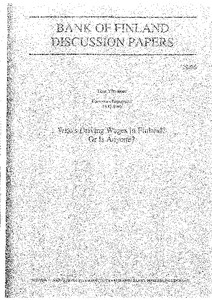Who's driving wages in Finland? : Or is anyone?
Tyrväinen, Timo (17.12.1996)
Numero
29/1996Julkaisija
Suomen Pankki
1996
Julkaisun pysyvä osoite on
https://urn.fi/URN:NBN:fi:bof-20140807677Tiivistelmä
This study examines wage paths in the Finnish manufacturing using the Johansen method in estimations.The empirical results have the following implications. i) Wage-wage links in the Finnish manufacturing industry have been tight.In a longer perspective, wages in the high-pay branches and low-pay branches have followed a common path. ii) An important characteristic of wage development in high-pay branches has been the tendency to counteract any attempts to improve the relative position of the low-pay branches with additional wage increases.A major part of the adjustment through which earlier wage structures have been restored has taken place within one year. iii) The adjustment process due to wage-wage links seems to have changed since the devaluation of the markka in November 1991. Result (ii) is of great interest for Finland and the other Nordic countries.This is because in Northern Europe wage settlements have been commonly designed to reduce wage differentials.In the Scandinavian literature, these have often been called "solidarity" or "solidaristic" type contracts. The results imply that when wage differentials have been compressed through institutional arrangements, market forces have counteracted and nullified the effects on wage structures.These forces include both local and branch-specific trade union bodies as well as employers.Resulting wage adjustment has been so quick that most of it must be attributable to wage drift.For analysis of the Finnish inflation history it is of great interest to notice that efforts to reduce wage differentials through incomes policy have led to additional inflation.The earlier wage structures have been fully restored and only a higher wage and price level - ie a loss in competitiveness - has remained. Against the commonly held view, wages in the low-pay sector have, in a sense, driven wages in the high-pay sector and "solidarity" in wage policy seems to have been part of the national behavioural model characterized by high inflation and repeated devaluations.In recent years, a change in this process appears to have taken place. Whether this is actually an indication of some profound change in wage-wage links remains to be seen. Key words: Wage determination, wage differentials, wage-wage links, solidaristic wage contracts.
